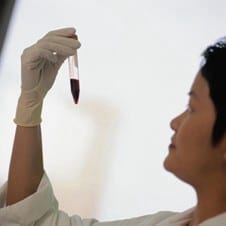Cancer is a scary word, but as you have learned by now, words give you the information you need to make knowledgeable decisions in consultation with your family physician and oncologist (cancer specialist).
Many cancer terms are unique to the field of oncology (study of tumors) and don’t lend themselves easily to the prefix, root, suffix system used in the previous modules. Instead, terms will be grouped and defined in broad categories such as tumor types, causes and treatments. In place of a quiz there will be a simulated case that reinforces frequently used terms.
Cancer buzz words
| Good news | Bad news |
|---|---|
| Benign | Malignant |
| Low grade | High grade |
| Radiosensitive | Radioresistant |
| No metastases | metastases |
| Well differentiated | Poorly differentiated |
| Negative nodes | Positive nodes |
| In remission | Relapse |
| Surgically resectable | Inoperable |
Tumor types
Malignant vs. benign (literally, “evil” versus “good”)
Tumors are masses of cells that have slipped the bonds of control of cell multiplication. Malignant tumors, cancers, are life-threatening because they are invasive (spread into surrounding organs) and metastasize (travel to other areas of the body to form new tumors). Specifically, invasiveness results in penetration, compression and destruction of surrounding tissue causing such problems as loss of organ function (liver, kidneys), difficulty breathing (lungs), obstruction (intestines), possible catastrophic bleeding and severe pain.
Carcinoma
Carcinoma is the most common form of cancer. Carcinoma develops from sheets of cells that cover a surface (example: skin) or line a body cavity (example: glandular lining of stomach). Some names for tumors of this type would be: adenocarcinoma of the prostate, adenocarcinoma of the lung, gastric adenocarcinoma, hepatocellular carcinoma (what organ is involved?). Note that the term carcinoma typically appears in the name.
Sarcoma
A rare form of cancer arises from connective and supportive tissues, examples: bone, fat, muscle, and other connective tissues. Some names of this type of tumor would be: osteosarcoma (malignancy of bone), liposarcoma (fat) and gastrointestinal stromal tumor. Note that the term sarcoma does not always appear in the name.
Grading and staging

A staging system using the letters T, N, M is also used in conjunction with Grading. “T” indicates size of tumor; “N” whether the cancer has spread into lymph nodes; “M” whether cancer cells have metastasized to other organs and areas. For example, a melanoma T2N0M0 describes a skin cancer that is between 1.0 and 2.0 mm in thickness, but has not spread into lymph nodes or other areas of the body.
Grading and staging tumors are important ways to predict the “prognosis” (progress and outcome of the disease), and which types of treatments may most likely succeed. In general, low grade tumors that have not invaded tissues, have not involved lymph nodes (negative nodes) and have not metastasized would be expected to have a better prognosis than a high grade tumor that has invaded tissues, has invaded lymphatics (positive nodes) and has metastasized. However, the prognosis of any individual patient is much more complicated than described here. Complicating factors include the general health of the patient, the effectiveness of their immune system and available treatment options. Some tumor types are very “aggressive” and are highly resistant to treatment.
Causes of cancer
Any injury to DNA (the genetic code) may result in the loss of cell cycle control, leading to uninhibited cell division. Carcinogens are cancer causing agents. Broad categories include radiation, chemicals, drugs and viruses. Don’t panic! Your once a year dental X-ray and common cold and flu viruses will not cause cancer. However, excessive radiation from nuclear to sunlight can significantly increase your risk of malignancy. The Human Papilloma Virus (HPV) is the major cause of cervical cancer. Environmental chemicals found in tobacco smoke, automotive exhaust, toxic emissions from factory smokestacks and asbestos exposure are all carcinogenic.
Curious about your risk for common cancers? Check in at Your Disease Risk at Washington University School of Medicine.